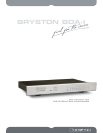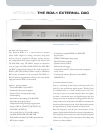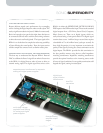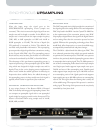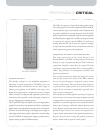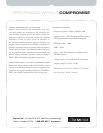
SYncHronouS upSAMpLiNG
UPSAMPLING
After the input stage, the signal goes to the
SYNCHRONOUS upsampling circuit (sample rate
converter). This circuit converts the digital signal from one
sample rate and bit depth to another. In the BDA-1, the
sample rate is increased from the input sample frequency
(32K, 48K, or 96K upsamples to 192K and 44.1K or
88.2K upsamples to 176.4K). The 16 bits of depth (the
CD standard) is increased to 24 bits. The added 8 bits
are filled with placeholder information. This upsampling
process provides a digital signal for later conversion to analog
by the Crystal 4398 DAC chip. The upsampling process
doesn’t add any new, but does put the data in a form which
can better be translated by the DAC as described below.
The advantage of this synchronous upsampling process is
improved processing of the upsampled signal by the DAC
chip, which was designed for higher sample rates and bit
depths. There is also a noise shaping process implemented
where “noise” within the audible spectrum is shifted up to
frequencies above audible limits. An added advantage of
this upsampling process is that a totally new clock signal is
applied, which results in significant jitter reduction.
OPTIONAL UPSAMPLING FEATURE
A very unique feature of the Bryston BDA-1 External
DAC is the ability to disengage the upsampling feature. You
can compare an upsampled signal with a non-upsampled
signal simply by engaging a switch on the front panel. This
feature is functional when using sample rates of 44.1K,
88.2K, 48K, and 96K.
BRYSTON DAC
The DAC integrated circuit (chip) provides the conversion of
the digital signal to the analog domain. The two independent
DAC chip’s used in the BDA-1 are the Crystal CS-4398. Due
to the requirements of the conversion process, every DAC
chip employs a digital filter to the signal in the digital domain
and an analog filter after the conversion process has been
applied. Without this upsampling technology, these filters
would likely effect frequencies at or near the audible range,
accompanied by unwanted level and phase changes.
The CS-4398 is a hybrid multi-bit delta-sigma DAC. This
is an advanced generation chip, which uses several methods
to optimize the conversion process. This DAC uses a process
similar to the previously detailed upsampling process where
it oversamples the incoming signal. The CS-4398 operates in
one of three oversampling modes based on the input sample
rate. Single-speed mode supports input sample rates up to
50 kHz and uses a 128x oversampling ratio. Double-speed
mode supports input sample rates up to 100 kHz and uses
an oversampling ratio of 64x. Quad-speed mode supports
input sample rates up to 200 kHz and uses an oversampling
ratio of 32x. This again allows for filtering that is safely out
of the audible range. The output of this process is a sensitive
analog signal. The timing of this process must be very closely
controlled by a low-jitter clock.
4



